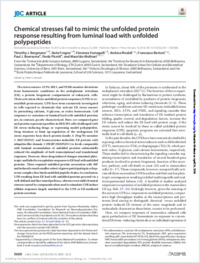Chemical stresses fail to mimic the unfolded protein response resulting from luminal load with unfolded polypeptides
- Bergmann, Timothy J. Institute for Research in Biomedicine (IRB), Faculty of Biomedical Sciences, Università della Svizzera italiana, Switzerland - Department of Biology, ETH Zurich, 8093 Zurich, Switzerland
- Fregno, Ilaria Institute for Research in Biomedicine (IRB), Faculty of Biomedical Sciences, Università della Svizzera italiana, Switzerland - Department of Biology, ETH Zurich, 8093 Zurich, Switzerland
- Fumagalli, Fiorenza Institute for Research in Biomedicine (IRB), Faculty of Biomedical Sciences, Università della Svizzera italiana, Switzerland - Graduate School for Cellular and Biomedical Sciences, University of Bern, 3001 Bern, Switzerland
- Rinaldi, Andrea Institute for Research in Biomedicine (IRB), Faculty of Biomedical Sciences, Università della Svizzera italiana, Switzerland - Institute of Oncology Research (IOR), Faculty of Biomedical Sciences, Università della Svizzera italiana, Switzerland
- Bertoni, Francesco Institute for Research in Biomedicine (IRB), Faculty of Biomedical Sciences, Università della Svizzera italiana, Switzerland - Institute of Oncology Research (IOR), Faculty of Biomedical Sciences, Università della Svizzera italiana, Switzerland
- Boersema, Paul J. Department of Biology, ETH Zurich, 8093 Zurich, Switzerland
- Picotti, Paola Department of Biology, ETH Zurich, 8093 Zurich, Switzerland
- Molinari, Maurizio Institute for Research in Biomedicine (IRB), Faculty of Biomedical Sciences, Università della Svizzera italiana, Switzerland - École Polytechnique Fédérale de Lausanne, School of Life Sciences, 1015 Lausanne, Switzerland
-
16.02.2018
Published in:
- Journal of biological chemistry. - 2018, vol. 293, no. 15, p. 5600-5612
ER quality control
Endoplasmic reticulum stress (ER stress)
Molecular chaperone
Protein folding
Protein misfolding
Unfolded protein response (UPR)
English
The stress sensors ATF6, IRE1, and PERK monitor deviations from homeostatic conditions in the endoplasmic reticulum (ER), a protein biogenesis compartment of eukaryotic cells. Their activation elicits unfolded protein responses (UPR) to reestablish proteostasis. UPR have been extensively investigated in cells exposed to chemicals that activate ER stress sensors by perturbing calcium, N-glycans, or redox homeostasis. Cell responses to variations in luminal load with unfolded proteins are, in contrast, poorly characterized. Here, we compared gene and protein expression profiles in HEK293 cells challenged with ER stress–inducing drugs or expressing model polypeptides. Drug titration to limit up-regulation of the endogenous ER stress reporters heat shock protein family A (Hsp70) member 5 (BiP/HSPA5) and homocysteine-inducible ER protein with ubiquitin-like domain 1 (HERP/HERPUD1) to levels comparable with luminal accumulation of unfolded proteins substantially reduced the amplitude of both transcriptional and translational responses. However, these drug-induced changes remained pleiotropic and failed to recapitulate responses toERload with unfolded proteins. These required unfolded protein association with BiP andinduced amuchsmaller subset of genes participating in a chaperone complex that binds unfolded peptide chains. In conclusion, UPR resulting from ER load with unfolded proteins proceed via a well-defined and fine-tuned pathway, whereas even mild chemical stresses caused by compounds often used to stimulate UPR induce cellular responses largely unrelated to the UPR or ER-mediated protein secretion.
- Language
-
- English
- Classification
- Medicine
- License
- Open access status
- gold
- Identifiers
-
- RERO DOC 324186
- DOI 10.1074/jbc.RA117.001484
- ARK ark:/12658/srd1318888
- Persistent URL
- https://n2t.net/ark:/12658/srd1318888
Statistics
Document views: 224
File downloads:
- Versione pubblicata: 215
